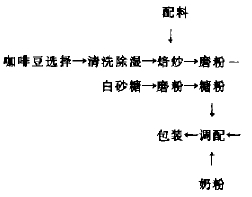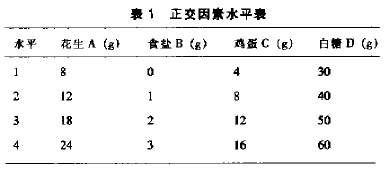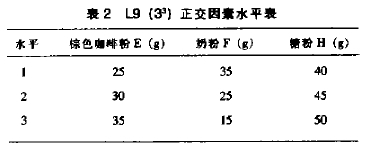Development of Fine Coffee with Common sense Flavor
Caffeine varieties, origin, with different flavor and coffee components, need to be reasonable deployment. In order to make its aroma components and coffee nutrients complementary, the coffee powder produced has a good flavor. Due to lack of coffee raw materials. Coffee drinks are expensive, coffee is only used as high-end drinks, and the consumption market is very small. The production of instant coffee has a large investment in production equipment, which makes it impossible for small and medium-sized towns to produce coffee raw materials and can only sell raw materials. Pure coffee taste too bitter, our eating habits make most of the population bitter drink crystal is not adapted.
Flavor coffee production equipment investment is small, easy to operate, bitter taste reduced, only a single variety and other ingredients mixed stir-fry (different varieties of coffee roasting ingredients can be appropriately adjusted), to obtain coffee color flavor based brown coffee powder, and then prepared with good flavor, drinking convenient flavor coffee.
I. Materials and Methods
1. raw materials
Coffee beans (variety Katim)
Eggs (commercially available)
White granulated sugar (no moisture absorption)
Peanut kernel red (commercial)
Salt (commercially available)
Milk powder (whole milk powder, commercially available)
2. process flow

3. main instruments
Stainless steel frying pan, ordinary mill, 40 mesh sieve, electric stove, electric fan, egg beater.
4. operation points
(1)Coffee Bean Selection
Choose first class beans to second class beans, no mold beans and stinky beans.
(2)cleaning and dehumidifying
Put the coffee beans into a washing tank to wash away the dust and dirt adhered to the surface of the beans, and remove and drain the water.
(3)roasted
Put the coffee beans into the hot pan, fry the coffee beans to yellow when the silver skin falls off, blow off the silver skin with an electric fan, fry for about 25 minutes, the coffee beans become light brown. Add salt and peanut kernel continue to fry, at this time a lot of silver peel off, blow with an electric fan to remove the silver peel, fry until the peanut kernel turns yellow (about 9 minutes). Add the eggs (remove the shells and whip with an egg beater) and saute until browned (about 11 minutes). Slowly add the white sugar, stirring while adding the white sugar, and stir the white sugar. Turn off the electric furnace, use the waste heat, fry until the sugar on the surface of the bean material does not stick to the hand, and touch the bean material with the hand to feel rough (about 10 minutes). The baking process takes about 55 minutes.
(4)milling
After the fried coffee beans are completely cooled, they are ground into powder by an ordinary grinder, and brown coffee powder is sieved by a 40-mesh sieve. The coffee particles on the sieve surface are ground into a second shape, and then sieved by a 40-mesh sieve. The small particles on the sieve surface are only 0.1% of the weight of the fried coffee beans, and the coffee powder under the sieve surface is evenly mixed.
(5)deployment
Brown coffee powder, milk powder and sugar powder are mixed evenly according to the best formula to increase nutrition and flavor and taste.
(6)packaging
After the preparation is completed, immediately pack it with composite plastic film bag, and seal it tightly without air leakage.
II. RESULTS AND DISCUSSION
1. Determination of the Best Roasting Formula
The flavor of coffee powder is closely related to the proportion and order of peanut, salt, egg and white sugar. Roasting fixed coffee beans for 200 grams, peanut quantity A, salt quantity B, egg quantity C, sugar quantity D for four factors to do
See Table 1 for orthogonal test

By orthogonal test and variance analysis, the optimum formula was A3B3C4D3, i. e. peanut 18g, salt 1g, egg 16g, white sugar 50g.
2. Effect of Roasting on Brown Coffee Powder
Roasting causes physical and chemical changes in coffee beans and ingredients, which determine the color and flavor of brown coffee powder.
When roasted, raw beans contain sucrose and sugar to melt into caramel. It mainly affects the color of roasted coffee; the pentosan contained in coffee beans is partially degraded to produce uraldehyde during roasting, which makes roasted coffee have a special grain aroma. In the roasting process, the formation and decomposition of acids occur at the same time, about 7% of chlorogenic acid contained in raw beans is destroyed by 1/3 or even 1/2; acetic acid is lost, its content is nearly 0.4%; this makes the pH value of coffee powder about 5.1, add 1 gram, make sour taste softer and taste less salty. In the roasting process, the nonvolatile components of coffee are converted into volatile components, such as fatty acids and lipids decomposed into aliphatic hydrocarbons, N-methyl nicotinic acid inner salts converted into nitrogen-containing compounds, high terpenes decomposed into monoterpenes, etc. This gives roasted coffee a special flavor.
Raw beans contain about 13% protein, peanuts contain about 27% protein, egg protein 13%-15%, due to the effect of high heat protein structure changes, such as peptide hydrolysis, amino bond denaturation and the formation of new covalent isopeptide bonds, hydrolysis release methyl sulfate and methyl mercaptan. Fragrance is better. Due to high temperature, moisture content, salt, pH value, add eggs will immediately solidify, roast coffee beans must be quickly stirred, so that add eggs less and smaller lumps.
Aroma produced by roasted peanuts contains carbonyl compounds. Special aroma components include pentapyrazine compounds and N-methyl pyrrole. Among them, a-arachidin provides special aroma for fried peanuts. Peanut contains 47% peanut oil, is a non-drying oil, the most difficult polymerization, does not affect the color of coffee.
Volatile substances and other substances produced in the roasting process of peanuts and eggs make up for the defect that there is no specific flavor after roasting of a single variety of coffee, so that the flavor of coffee is mellow and thick.
3. Selection of the Best Formula of Flavor Coffee
Brown coffee powder E, milk powder F, sugar powder H, the sum of the three powders is 100g. 20 tasters with certain representativeness were randomly selected, and each of them evaluated 9 formula combinations. After the flavor index scores of each combination were counted, the sensory evaluation flavor index values (average values) were obtained. See Table 2 for statistics and calculation.

According to Table 2, the optimal formula E3F2H1 was obtained, i.e. coffee powder was 35g, milk powder was 25g and sugar powder was 40g.
4. product quality
(1)sensory index
Color: Brown mixed with white.
Gas: coffee incense mainly, light frankincense, smell fragrance for a long time, no peculiar smell.
Taste: sweet, strong coffee flavor, mellow taste, bitter light.
Form: Powder and a small amount of small particles, no moisture agglomeration or agglomeration.
(2)microbial indicators
Pathogenic vaccine could not be detected;
No mildew phenomenon caused by microbial action.
Important Notice :
前街咖啡 FrontStreet Coffee has moved to new addredd:
FrontStreet Coffee Address: 315,Donghua East Road,GuangZhou
Tel:020 38364473
- Prev

General knowledge of boutique coffee about coffee bean grinding
The concept and principle of coffee grinding: the operation of crushing roasted coffee beans is called grinding. The props used to grind coffee beans are called grinders. The ideal time to grind coffee is to grind it before cooking. Because ground coffee is easy to oxidize and lose its flavor, especially without proper storage, coffee powder is also easy to change flavor, so it is naturally impossible to cook mellow coffee. Some
- Next

Basic knowledge of Fine Coffee Coffee Grinding method
The task of grinding roasted coffee beans into powder is called grinding coffee beans, and the props are called grinders. Beethoven counts sixty coffee beans every morning and grinds them into a grinder. Beethoven grinds the coffee while enjoying its aroma and then excitedly experiences the fun coffee beans. The dark brown beans seem ordinary, but they have a lot of knowledge at all stages.
Related
- Beginners will see the "Coffee pull flower" guide!
- What is the difference between ice blog purified milk and ordinary milk coffee?
- Why is the Philippines the largest producer of crops in Liberia?
- For coffee extraction, should the fine powder be retained?
- How does extracted espresso fill pressed powder? How much strength does it take to press the powder?
- How to make jasmine cold extract coffee? Is the jasmine + latte good?
- Will this little toy really make the coffee taste better? How does Lily Drip affect coffee extraction?
- Will the action of slapping the filter cup also affect coffee extraction?
- What's the difference between powder-to-water ratio and powder-to-liquid ratio?
- What is the Ethiopian local species? What does it have to do with Heirloom native species?

